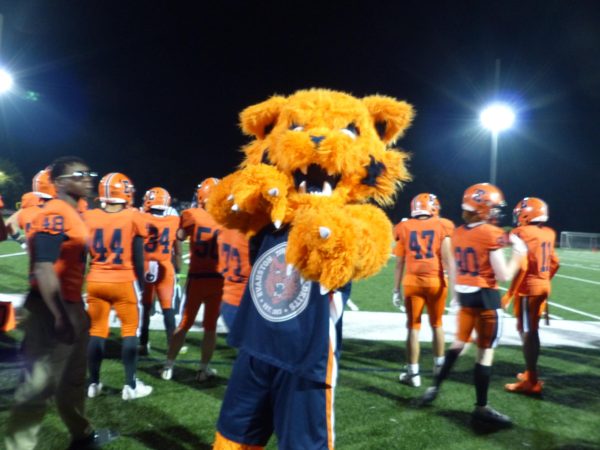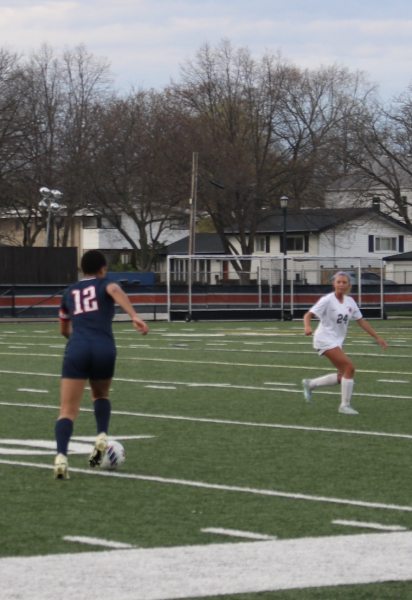Letter from the editor | On the need for a more human-centered sports section
In sports journalism, it’s easy for creators and consumers to objectify athletes. Frequently, competitors are regarded in stories solely for their material value: their point averages, their personal-bests, how much weight they can lift, etc.
Like most publications, The Evanstonian is no stranger to this. As the Sports Editor, I have frequently found myself encouraging staff writers to focus more on covering scores and statistics and less on team dynamics and traditions. Coming into this role having only written in Sports once, I thought that stripped down, play-by-play reports akin to scorebooks were the only stories that worked in the section.
“People don’t care about whether or not the field hockey team finished the season with a stronger bond,” I thought. “They care about whether they beat New Trier and Loyola.”
After a semester in Sports though, I’ve learned that this way of thinking is not only flawed, but harmful. While acting as if athletes’ on-field accomplishments meant nothing would be a disservice to them, it would also be a disservice to act as if they were the only things that mattered. When covering sports, one must strike a balance between documenting what athletes do and who they are as people.
One of my favorite quotes, although perhaps cliché, is from Maya Angelou: “I’ve learned that people will forget what you said, people will forget what you did, but people will never forget how you made them feel.” The same applies to sports journalism. For instance, the Cubs victory in Game 7 of the 2016 World Series. People don’t remember that Dexter Fowler hit a lead-off home run, that the Cubs at one point held a 5-1 lead or that Ben Zobrist won the World Series MVP award that day. Rather, they remember the pure elation the team felt as a result of winning an MLB title for the first time in 108 years. The best stories written about that win focused on that feeling. In sports, people will forget about the particulars of certain moments,—the how far, the how fast, the how much—but never forget about the feelings those moments elicited. That is what sports journalists should dedicate at least equal amounts of time to documenting, along with specified facts and figures.
But in spite of that, The Evanstonian is limited in size and scope and that often inhibits Sports from reporting on these moments in an engaging and comprehensive fashion. Compared to those of non-high school newspapers, our resources are pithy, and between school, sports of our own and other commitments, staff writers frequently cannot put in as much time as they ideally would like to into stories. As a result, we have to be economical with our writing, and the effects of this economicality can be seen throughout Sports: rundowns exclusively cover varsity teams, the same athletes tend to be quoted throughout their seasons, and the more success a team has, as well as the more popular the sport that team belongs to, the longer the story often is. As an editor, time constraints on top of my preconceived beliefs about sports journalism led to many of Sports’ stories this semester reflecting that stripped down, play-by-play documentation that I now believe to be detrimental to everyone involved.
Next semester, I want to focus my writing equally on the experiences as well as on the performances of ETHS athletes. As a result of this, I want to cover not just varsity, but junior varsity and frosh/soph athletes as the most important, thought-provoking and inspiring ETHS sports stories may not always come from the varsity level. I want ETHS athletes to not only find Sports accessible, but also to find it representative. Regardless of level, if any Evanston athlete has a sports story they want to share, I want them to feel like this section could be the vehicle in helping them reach a wider audience. And I aspire to all of these goals in the name of making the section more human-centered.
Recently, it came to my attention that Sports Illustrated has, for the last sixty-five years, run a segment called “Faces In The Crowd.” Despite initially being started to focus on up-and-coming amateur athletes, today, “Faces In The Crowd” has also broadened its purpose to include athletes who will never receive widespread recognition.
“We’ve also highlighted countless athletes whose glory days may never extend beyond the high school, college, or masters level—the athletes who play simply for the love of the game—and these everyday athletic heroes are the lifeblood of Faces in the Crowd.”
After perusing a selection of the segment’s pieces, I have come to the conclusion that these kinds of stories, heartfelt, uplifting pieces anchored in such themes as passion and perseverance, should also be the lifeblood of The Evanstonian’s Sports section. From this point forward, “How do sports at Evanston affect Evanstonians?” will be the guiding question of this section’s coverage.
In 2050, it won’t matter anymore whether Evanston or New Trier won the annual football game in 2021. Instead, what will matter is how being on the football team, being present at the games or even not being able to be at the game impacted people on an individual and communal level. That is ultimately what ought to be documented, and it is my goal next semester and onward to do a better job of doing that.
Your donation will support the student journalists of the Evanstonian. We are planning a big trip to the Journalism Educators Association conference in Philadelphia in November 2023, and any support will go towards making that trip a reality. Contributions will appear as a charge from SNOSite. Donations are NOT tax-deductible.






